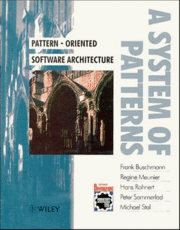Party of Five 1996
m (Reverted edits by Ebybymic (Talk); changed back to last version by Matthew Harward) |
|||
| (3 intermediate revisions by 2 users not shown) | |||
| Line 1: | Line 1: | ||
==Details== | ==Details== | ||
| + | [[Image:PartyOfFive.gif|thumb|left]] | ||
| + | |||
'''Title:''' Pattern-Oriented Software Architecture Volume 1: A System of Patterns | '''Title:''' Pattern-Oriented Software Architecture Volume 1: A System of Patterns | ||
| Line 12: | Line 14: | ||
'''Provided Synopsis:''' | '''Provided Synopsis:''' | ||
Pattern-oriented software architecture is a new approach to software development. This book represents the progression and evolution of the pattern approach into a system of patterns capable of describing and documenting large-scale applications. A pattern system provides, on one level, a pool of proven solutions to many recurring design problems. On another it shows how to combine individual patterns into heterogeneous structures and as such it can be used to facilitate a constructive development of software systems. Uniquely, the patterns that are presented in this book span several levels of abstraction, from high-level architectural patterns and medium-level design patterns to low-level idioms. The intention of, and motivation for, this book is to support both novices and experts in software development. Novices will gain from the experience inherent in pattern descriptions and experts will hopefully make use of, add to, extend and modify patterns to tailor them to their own needs. None of the pattern descriptions are cast in stone and, just as they are borne from experience, it is expected that further use will feed in and refine individual patterns and produce an evolving system of patterns. | Pattern-oriented software architecture is a new approach to software development. This book represents the progression and evolution of the pattern approach into a system of patterns capable of describing and documenting large-scale applications. A pattern system provides, on one level, a pool of proven solutions to many recurring design problems. On another it shows how to combine individual patterns into heterogeneous structures and as such it can be used to facilitate a constructive development of software systems. Uniquely, the patterns that are presented in this book span several levels of abstraction, from high-level architectural patterns and medium-level design patterns to low-level idioms. The intention of, and motivation for, this book is to support both novices and experts in software development. Novices will gain from the experience inherent in pattern descriptions and experts will hopefully make use of, add to, extend and modify patterns to tailor them to their own needs. None of the pattern descriptions are cast in stone and, just as they are borne from experience, it is expected that further use will feed in and refine individual patterns and produce an evolving system of patterns. | ||
| + | |||
| + | [[Category: Resources]] | ||
Latest revision as of 03:22, 25 November 2010
Details
Title: Pattern-Oriented Software Architecture Volume 1: A System of Patterns
Authors: Frank Buschmann, Regine Meunier, Hans Rohnert, Peter Sommerlad, Michael Stal. aka Party of Five
Year: 1996
Publisher: Wiley
Link: Amazon
Provided Synopsis: Pattern-oriented software architecture is a new approach to software development. This book represents the progression and evolution of the pattern approach into a system of patterns capable of describing and documenting large-scale applications. A pattern system provides, on one level, a pool of proven solutions to many recurring design problems. On another it shows how to combine individual patterns into heterogeneous structures and as such it can be used to facilitate a constructive development of software systems. Uniquely, the patterns that are presented in this book span several levels of abstraction, from high-level architectural patterns and medium-level design patterns to low-level idioms. The intention of, and motivation for, this book is to support both novices and experts in software development. Novices will gain from the experience inherent in pattern descriptions and experts will hopefully make use of, add to, extend and modify patterns to tailor them to their own needs. None of the pattern descriptions are cast in stone and, just as they are borne from experience, it is expected that further use will feed in and refine individual patterns and produce an evolving system of patterns.
